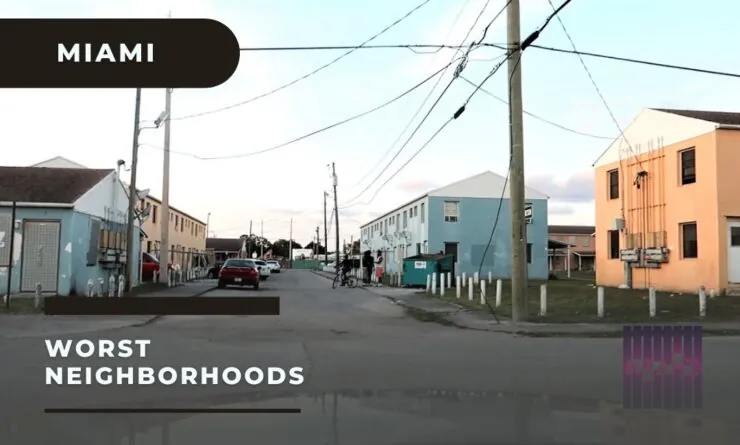Miami is a city that is considered relatively safe when compared to other cities of a similar size. Nevertheless, there are certain areas and neighborhoods in Miami that are considered to be unsafe and should be avoided. If you want to keep yourself safe while in Miami, it is important to be aware of these dangerous neighborhoods. Read on to find out more about which neighborhoods in Miami are considered to be the most dangerous.
How Safe is Miami?
Miami is actually quite safe, particularly if you stick to the downtown and tourist areas. As a popular vacation destination and home to many celebrities, the local police take great care to maintain a secure environment.
Miami is a great city with several safe and desirable areas. However, like any other city, it also has some places that are less than desirable. The Downtown and Northern Miami areas are known for their high crime rates, while the southern parts of the city are considered to be much safer. Despite these areas being less safe, it’s important to note that Miami does not rank among the most dangerous cities in America. Nevertheless, it’s always recommended to exercise caution or avoid visiting these neighborhoods altogether.
If you’re curious about the most perilous areas in Miami, you’re in the right place. Here are the ten neighborhoods in Miami that are considered the most dangerous. Keep reading to learn more.
10 Most Dangerous Neighborhoods in Miami
Model City
Model City is known to be the most dangerous neighborhood in Miami. It has a population of 25,023 and is infamous for its high rates of violent crime. Located in the Northwest quadrant of the city, the area is heavily associated with drug trade, which contributes to the prevalence of gun violence, burglaries, robberies, and drive-by shootings. Over the years, the number of murders has steadily increased, going up by 40% between 2011 and 2013. While there has been some improvement due to increased police presence, it is still not safe to walk or bike through the neighborhood, especially at night.
Overtown
With a population of 9,640 residents, Overtown stands as one of the most historically significant neighborhoods in Miami. Despite an active police presence, criminal activities such as drug trafficking, assaults, and shootings still pose a threat in the residential area. Shockingly, violent crimes in Overtown were recorded at a staggering 124% higher than the national average in 2020. Due to the prevalence of such predatory crimes, it is not advisable to walk or bike alone in the area, especially after dark.
Downtown
Downtown Miami has a reputation for being one of the most violent areas in the city. With a population of 30,500, the violent crime rate is 186% higher than the national average. In 2022, the chances of becoming a victim of any crime in this area are around 10%, while the chances of becoming a victim of a violent crime are 1.2%. To safely explore downtown, it’s recommended to do so during the daytime while walking or biking. Gang activity is prevalent in this part of the city, and it is advised to avoid walking alone outside of the tourist areas as it can be dangerous. The corners of Miami are often inhabited by homeless people, and panhandling is a common issue. Additionally, passengers are advised to watch out for thieves and pickpockets while using public transit.
Allapattah
Allapattah is situated to the north of downtown and has a population of approximately 48,221 people. It was once a residential village primarily occupied by Dominicans, but now it boasts of a diverse population. Although the crime rate in Allapattah is not unusually high, there are certain pockets of the neighborhood that are prone to criminal activity. Unfortunately, the area has gained a bad reputation in Miami due to the occurrence of shootings. Despite the heavy police presence, crime rates in Allapattah are still 125% higher than the national average. During the day and evening, it is relatively safe to walk or ride a bike in Allapattah, but it is advisable to avoid areas to the east of 9th Ave and north of 20th St as they have a reputation for being unsafe due to the presence of criminal elements. Public transportation is available and considered relatively safe.
Little Haiti
Little Haiti, with a population of approximately 29,760, is a community situated to the north of Downtown Miami. Little Haiti was originally established by Haitian immigrants and other Caribbean residents and was known as Lemon City. Despite the Hispanic culture being prevalent in the area, the community unfortunately has a high crime rate. Incidents of shootings, assaults, and other violent crimes are common in Little Haiti, with the violent crime rate being 200% higher than the national average. According to the residents, the police are not particularly active in the community. Therefore, if you plan to visit Little Haiti, it is best to do so during the daytime as nighttime can be dangerous.
Little Havana
Little Havana is situated west of downtown Miami and has a population of approximately 76,163. It is renowned for its Cuban heritage and a variety of restaurants that serve scrumptious Cuban cuisines. Nevertheless, gang-related violence is still a prevalent issue in the area. Despite a decline in crime rates in recent years, violent crime and property crime continue to occur. Many local residents believe that the police presence is insufficient. However, there are some safe areas around Little Havana, such as west of 22 Ave and south of 8 St, as well as the central part, which is a popular tourist destination. Public transportation is available and a secure way to travel around the city.
Wynwood
Wynwood is home to approximately 17,923 residents and is situated to the north of Miami, and south of the Design District of Little Haiti. Unfortunately, property crime is widespread and incidents of car theft, vandalism, assault, and other forms of theft are common. While this neighborhood is considered safer than 23% of Florida’s Miami neighborhoods, the violent crime rate is significantly higher, with a staggering 285% above the national average. Shockingly, in 2021, the police received reports of 726 violent crimes and 6,542 property crimes, and it’s believed that many cases of violent crime go unreported.
West Flagler
West Flagler, a neighborhood located west of Miami, is home to approximately 49,734 residents. While it is possible to walk around the area both day and night, it is recommended that you avoid traveling alone. Petty crimes are prevalent in this neighborhood, with burglary being a common occurrence. The crime rate in West Flagler is relatively high, with 2,427 crimes reported per 100,000 residents. Out of those reported crimes, 2,158 consist of theft, vehicle theft, and burglary.
Upper Eastside
With a population of 7,725, the Upper Eastside is considered to be one of the most dangerous neighborhoods in Miami, located to the east of Little Haiti. The violent crime rates in this area are alarmingly high, with a rate of 230% higher than the national average.
Living in an area with high crime rates can be a daunting experience as it poses various risks to one’s safety. Despite this, the authorities have taken steps to ensure that the residents are protected by maintaining a significant police presence that responds quickly to any criminal activity.
10. South Coconut Grove
The Grove, as it’s commonly known to the locals, is home to a population of 7,956. Coconut Grove seems to have mixed reviews regarding safety. Statistical data shows that North Coconut Grove is relatively safer than the rest of Miami, with a 55% lower crime rate. However, South Coconut Grove is known to be more dangerous, particularly during nighttime. The total crime rate in Coconut Grove is slightly higher than the national average by 5%, with violent crime being 12% higher than the national average. Despite this, there is a visible police presence, making walking or biking relatively safe.



